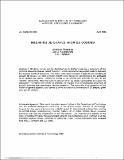| dc.description.abstract | All plane curves can be described at an abstract level by a sequence of five primitive elemental shapes, called "condons", which capture the sequential relations between the singular points of curvature. The condon description provides a basis for enumerating all smooth 2D curves. Let each of these smooth plane be considered as the si lhouette of an opaque 3D object. Clearly an in finity of 3D objects can generate any one of ou r "condon" silhouettes. How then can we p redict which 3D object corresponds to a g iven 2D silhouette? To restrict the infinity of choices, we impose three mathematical properties of smooth surfaces plus one simple viewing constraint. The constraint is an extension of the notion of general position, and seems to drive our preferred inferences of 3D shapes, given only the 2D contour. | en_US |
